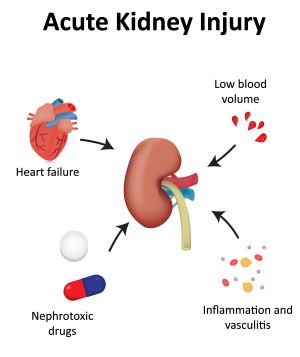What causes AKI (acute kidney injury)?
9 key causes of AKI
The ‘VOID-RIGHT’ mnemonic is useful:
- V – vasculitis (e.g. lupus (SLE) nephritis; all rare)
- O – obstruction
- I – infection (sepsis)
- D – dehydration
- R – renal artery stenosis (with bilateral thrombosis)
- I – interstitial disease (acute tubular necrosis (ATN); drugs (e.g. antibiotics, NSAIS, ACE/ARBs, contrast nephropathy))
- G – glomerulonephritis (e.g. crescentic IgA nephropathy; all rare)
- H – haemolytic-uraemic syndrome (very rare; is it Friday!?)
- T – thrombo-embolism (e.g. bilateral renal vein thrombosis; also very rare)
In this article we will describe these and other causes of AKI.
The causes of acute kidney injury can be divided into prerenal, renal and post-renal. These phrases mean problems with the blood supply to the kidneys (pre), the kidneys themselves (renal), and the urine drainage pipes or bladder (post).

Pre-renal
- Dehydration and infection (sepsis) are the commonest causes, partly as they cause hypotension (low blood pressure) which leads to a lack of blood going to the kidneys. Other causes include:
- Bleeding (haemorrhage)
- Cardiac failure
- Low blood pressure (of other causes)
- Liver failure
- Bilateral renal artery thrombosis (e.g. usually occurs on the background of renal artery stenosis, RAS)
- Bilateral renal vein thrombosis (can be a complication of severe nephrotic syndrome).
Renal
- Tubulo-interstitial disease (TID)
- Acute Tubular Necrosis (ATN). This is the commonest TI cause. It is usually secondary to prolonged hypoperfusion (largely all the pre-renal causes). In ATN, the kidney is pre-programmed (for reasons we don’t understand) to ‘close down’ (blood goes to it and from it, but it is not filtered) for 10-14 days, and then it ‘opens up’ and starts doing its normal job again. Dialysis may be required during this period
- Acute tubulointerstitial nephritis (TIN) – inflammation of tubes between the glomeruli (tiny filters; in the medulla (inner area) of the kidney). It can be caused by drugs, infections or autoimmune disease
- Drugs toxic to the kidneys – e.g. NSAIDs, ACEi/ARBs, antibiotics (such as aminoglycosides like gentamicin), or chemotherapy (such as cisplatin) and the dye that is injected for CTs and other x-rays (contrast nephropathy)
- Autoimmune diseases (all rare), such as:
- Glomerulonephritis (GN) (inflammation of tiny filters in the cortex (outer area) of the kidney)
- Vasculitis (inflammation of small to medium sized blood vessels)
- Other: intra-tubular obstruction (multiple myeloma and rhabdomyolysis); or hepatorenal syndrome and haemolytic-uraemic syndrome (HUS; both very rare).
Post-renal
- In men, it is usually due to enlargement of the prostate gland (benign (BPH) or malignant)
- In women, pelvic cancer is commonest cause
- Bladder cancer is another cause and can affect men and women.
Note. Renal stones are not a common cause of AKI, but can do – usually if you have one kidney.
Multifactorial AKI
AKI is often multifactorial – e.g.
- Pre-, peri- and/or post-operative hypotension, combined with
- Sepsis, and
- Antibiotics to treat the sepsis.
Note. Hypotension often relates to the underlying cause, e.g. GI sepsis.
Summary
We have described the causes of AKI. We hope it has been useful.

